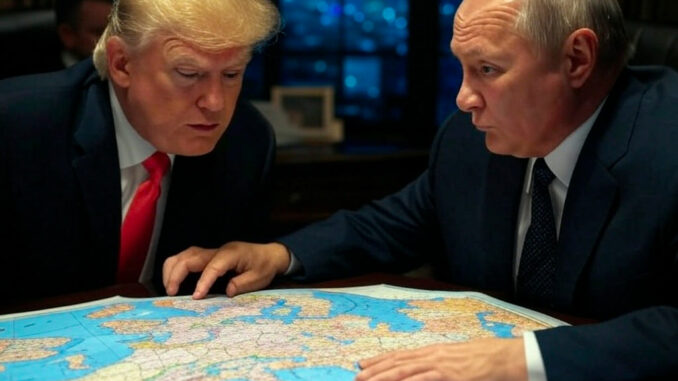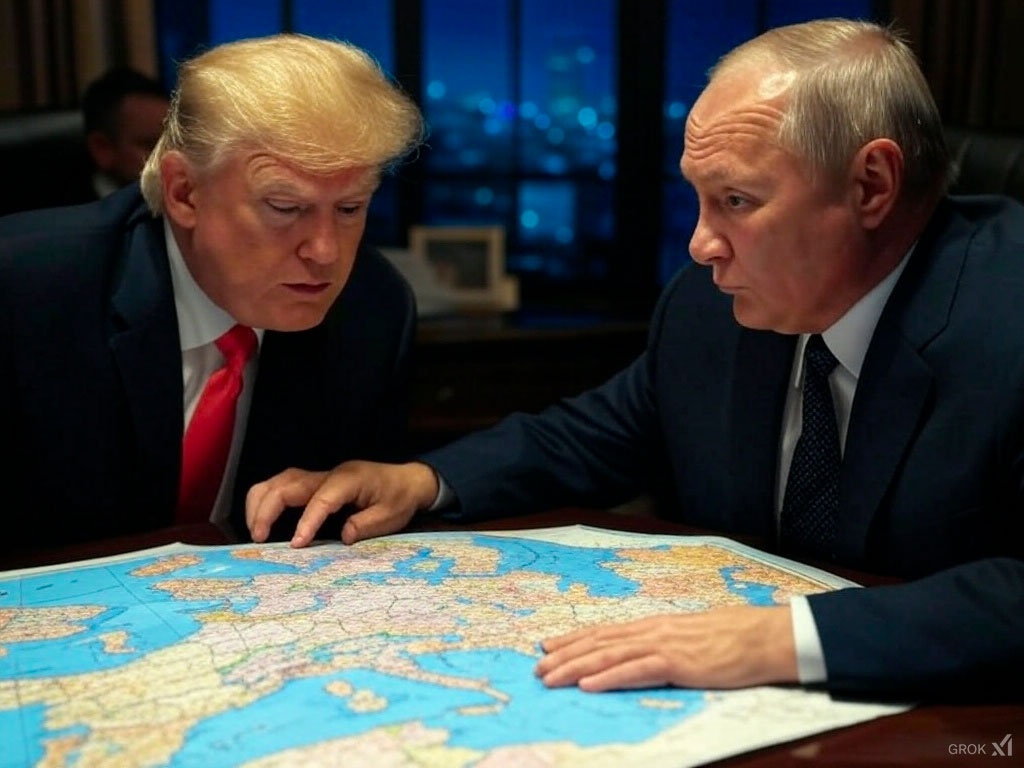
Analysis of the diplomatic and economic levers used by France and the EU to assert themselves in the face of the Trump-Putin initiative in the war in Ukraine.
Donald Trump is seeking peace in Ukraine in direct partnership with Vladimir Putin. In this perspective, Europe and Ukraine would be sidelined. This situation raises multiple issues for France and the European Union (EU). How should we react to an agreement between these two political figures that would act without the advice of Brussels and Kiev? This question is crucial for the stability of the continent and for the continuation of the armed conflict.
The following lines propose concrete actions for France and the EU to assert themselves in this matter. The recommendations are based on factual data and a pragmatic approach.
Strengthen the EU’s autonomous diplomacy
The European Union has already demonstrated its ability to unite 27 countries around common projects. Its combined GDP will reach 15,100 billion euros in 2021, giving it considerable weight in international negotiations. However, this potential sometimes remains under-exploited.
To increase its influence on the war in Ukraine, France and its partners should encourage the creation of a unified negotiating cell. This structure, supported by the European External Action Service, would bring together military, energy and diplomatic experts. Its task would be to make independent contact with Moscow and Washington.
The aim: to affirm the EU as a sovereign entity, capable of speaking with a single voice. This approach would guarantee greater responsiveness, and put Trump and Putin face to face with a bloc determined to defend European interests, not just American positions.

Exploiting economic and financial leverage
Relations between Europe and Russia have long been based on substantial trade. In 2021, almost 40% of the gas consumed in the EU came from Russia. By 2023, this figure has fallen to around 9%, thanks to energy diversification. This decline demonstrates Europe’s flexibility.
Despite this, economic partnerships remain in place. Sectors such as raw materials, technology and automobiles remain linked to Russian imports. To counter the Trump-Putin dynamic, the EU can accentuate existing sanctions or put forward targeted tariffs.
The idea is to exert measured pressure on Russian financial flows, without harming civilian populations. This pressure must be accompanied by discussion channels focused on long-term stability. France, the second largest economy in the euro zone, will play a leading role in promoting this coordinated strategy.
Consistent military support for Ukraine
Since the start of the war in Ukraine in February 2022, several member states have sent military equipment to Kiev. According to the Institute for the Study of War’s 2023 report, European deliveries amount to several billion euros.
However, the distribution of equipment remains sometimes dispersed. Some countries are cautious, others bolder. To gain credibility in negotiations, the EU must assume a more transparent military support role.
A unified arms delivery plan, validated by all members, would provide a showcase for European solidarity. This would involve setting a common target, for example 2% of GDP devoted to European defense, as some leaders are already proposing. This mutualization would give France and the EU a strategic advantage when talking to Putin and Trump.
Developing an extended deterrent capability
Ukraine wants security guarantees. France and the UK are the only nuclear powers in Western Europe (apart from Russia). Paris has around 290 nuclear warheads, according to the Stockholm International Peace Research Institute’s inventory (2023 figures).
A concrete proposal would be to initiate a European dialogue on collective deterrence. Although this is a sensitive subject, it would underline the fact that Europe does not need American protection to defend itself.
From a diplomatic point of view, this idea reinforces the image of a Europe capable of ensuring its own security and that of its partners. The signal sent to Moscow and Washington would be clear: the EU stands ready to guarantee the protection of its territory on its own.
Investing in Ukraine’s reconstruction
The prospect of reconstruction is already the subject of debate. According to the World Bank, rebuilding Ukraine’s infrastructure could cost between 350 and 500 billion euros.
Trump and Putin could impose a peace agreement that would exclude Ukraine from a large part of the negotiations, leaving the country in a weak position. To counter this scenario, France and the EU must commit to a well-targeted reconstruction plan, in collaboration with Kiev.
This approach has several objectives:
- To provide assistance to areas affected by the fighting.
- Build a strong and lasting partnership with Ukraine.
- Show Russia and the United States that Europe is not a passive player.
By financing Ukraine’s modernization, the EU is consolidating its influence and preventing the country from falling into a humiliating face-off with Moscow.
Mobilizing the countries of Central and Eastern Europe
Poland, Romania, the Baltic states and other countries bordering Ukraine feel directly threatened. Their support for Kiev is therefore strong, both in humanitarian and military terms. In figures, Poland has provided over 2.5 billion euros in assistance between 2022 and 2023.
However, these countries could find themselves marginalized if a Trump-Putin agreement were to prevail. France has an opportunity here: it can draw closer to its eastern neighbors. Better integrating these nations into EU decision-making would give greater legitimacy to the European position.
Constant dialogue and collaboration on collective security projects would solidify a Franco-Polish or Franco-Baltic axis. This regional dynamic would then reinforce the EU’s credibility in resolving the conflict.

Putting pressure on Washington by playing the NATO card
The Atlantic Alliance, dominated by the United States, remains a pillar of European defense. However, the fact that the Americans fund NATO, to the tune of 70% of the total budget, gives Washington room to maneuver.
If Trump decides to ignore Europe in his peace process, France and its allies can recall that NATO is based on multilateral cooperation. A tougher tone towards the United States, on the diplomatic front, would serve to underline that Europe is not a subcontractor of American interests.
In practical terms, Paris can brandish the threat of redefining European contributions to NATO if the EU’s interests are flouted. This approach is risky, but it would send the message to Washington that Europe will not accept a binational diktat between Trump and Putin.
Communicate clearly with European citizens
National public opinion has a strong influence on political decisions. However, there are differences between EU countries: some prefer a firm stance towards Moscow, while others fear a costly escalation.
A clear and quantified communication effort on the war in Ukraine is needed. Financial contributions, military aid, security risks and energy bills must be set out unambiguously. Citizens need to understand why the EU is choosing this or that option, especially if Trump and Putin are proposing simplistic solutions.
At the French level, the executive should initiate more frequent debates in Parliament. Insofar as the war in Ukraine has a concrete impact on the national budget and foreign policy, regular consultation with elected representatives would reinforce the legitimacy of the choices made.
Preserving channels for dialogue with Moscow
Despite sanctions and tensions, the EU cannot totally break off trade with Russia. The bloc retains economic and strategic interests in this vast area. The key is to maintain diplomatic contacts, however limited, to avoid lasting blockages.
France has a long tradition of bilateral relations with Russia. Taking advantage of this historical link can be an asset. Without endorsing Russia’s actions in Ukraine, we can encourage discreet meetings.
Such discussions should never disregard Ukrainian sovereignty. But they are a way of pointing out to Moscow that Europe remains an actor that cannot be ignored.
The need for a united front
Trump and Putin may try to impose a minimalist compromise. In this scenario, Ukraine would find itself weakened and Europe neglected.
To avoid this, the only valid response is unity. The initiatives listed above, whether diplomatic, economic, military or political, all depend on the willingness of EU member states to act in solidarity.
France, with its strong position on the UN Security Council and its nuclear capabilities, can spearhead this movement. Other nations, particularly those of Central Europe, will find this a guarantee of credibility.
The outcome of the conflict will depend on the EU’s ability to assert its choices. Without this cohesion, the Trump-Putin tandem will shape Ukraine’s future without a solid counterweight. With a united response, Europe can weigh in on the war in Ukraine and defend its fundamental interests, while contributing to a negotiated and lasting peace.
War Wings Daily is an independant magazine.